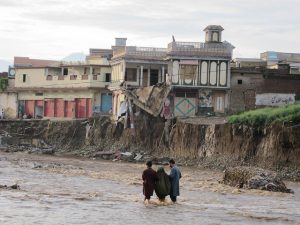Bolivia’s Salar de Uyuni is not what it was. Located in the southwestern Potosí region, the once-immaculate 10,582 sq km salt plain – the second most popular tourist attraction in the country – has an unfamiliar hue.
Previously, on travelling across the blinding white surface, one could expect to come across mirages, multi-coloured lakes and even flamingos or geysers. This time there are no flashes of light or oases on the world’s largest salt flat, just an inestimable number of artificial lakes, clunking machinery and workers. The new complex of laboratories, pilot plants, prospecting wells and pools covering 27 sq km of the southeastern part of the plain, situated 140km from the town of Uyuni, represents the dreams of more than a generation of politicians – a national lithium industry.
“With the exploitation of lithium in a 400 sq km area, we’ll have enough to maintain ourselves for a century,” Bolivia’s president Evo Morales boasted recently of the rare metal used in smart phone and electric car batteries. The government estimates that Bolivia stores around 70% of the world’s lithium reserves, some 100 million metric tonnes. The US Geological Survey puts the figure at a more modest 9 million tonnes.
But the nascent industry, which Chinese and German technology companies will help develop, involves more unknowns than knowns – especially with regards to the environmental impacts of extracting the lithium element from its carbon compound.
Morales announced that his government will invest US$ 995million in the development of the lithium industry between now and 2019. It is the second largest state investment after the US$ 1billion funnelled into the gas sector six years ago. Morales signed a contract with German company K-UTEC Ag Salt Techonologies to design a lithium carbonate pilot plant on August 16 and China’s Linyi Dake Trade has already constructed an ion lithium battery pilot plant on the site, which was inaugurated in March 2014. On July 13 this year, another Chinese company, CAMC Engineering, signed a contract to build a potassium salt industrial plant.
Chinese and German interest
Development of the salt flats is gathering momentum and Luis Echazú of the National Evaporite Resources Authority (GNRE in Spanish) recently hinted that there would soon be “another important announcement” from Bolivia and its German partners. Bulletins from the Ministry of Mining point to German and Chinese lobbying trips earlier this year, the formation of ‘bi-national mining chambers’ and dozens of visits by business delegations as evidence of progress.
Bolivia’s relationship with China has become much closer in 2015. On July 3, the Chinese ambassador to Bolivia, Wu Yuanshan, advised that the number of companies from his homeland was multiplying and that his government exercised “direct and indirect” controls over them. More than 35 Chinese enterprises have been attracted to Bolivia by infrastructure projects and natural resources like gas and iron.
According to GNRE’s records, 86 delegations from 15 countries visited the lithium carbonate plant; 28 from Germany and 12 from China.
“Mountains of sludge”
Lithium production means the Salar has ceased to be a confine exclusively for ecologists and tourists. Authorities are yet to advise on the changes that industrial exploitation will bring but heavy vehicles, toxic residues and major power lines will all be commonplace on the site when operations begin in 2018.
Research carried out by the Center for the Study of Labour and Agrarian Development (CEDLA in Spanish) sparked concern over the anticipated environmental impacts of the Uyuni project. Citing declarations from Echazú, CEDLA warned of the risk of widespread pollution, including the calcination of soil which would put the Salar’s flora and fauna at risk.
“Echazú told us that he was having nightmares about the use of lime-based technologies,” said Ricardo Calla, one of CEDLA’s researchers, who added that they have already been used in the pilot plant. “He said they wouldn’t create just a small hill but ‘mountains of residual sludge’.”
But Echazú emphatically rejected the statements: “I told CEDLA that there would be mountains of residue, but only if they used lime-based technology. We changed the process for economic and environmental reasons,” he said, adding that they would use sulfate technology that used much less lime.
“With calcimine, we would have had to use 10 tonnes of lime, with the new technology we’ll only use 0.3 tonnes,” Echazú said. And how much – Diálogo Chino asked Echazú – would this new process impact the environment? “Minimally,” he replied, adding; “sulfate is a fertilizer and what’s more it’s insoluble. We expect to sell some of these residues in the future.”
Graciela León, the boss of a nearby plant at Llipi, agrees and estimates the maximum environmental impact of the process to be “almost zero”.
Calla is certain that there have been no studies on the environmental impacts of sulfate techniques and warns that experimental work is being carried out by inexperienced personnel. None of the technicians are recognized as having postgraduate studies and the majority of them are in their twenties, Calla says. Calla also points to an earlier uncompleted study, carried out five years ago by the now-dissolved Salar Scientific Committee, which was compiled by post-doctoral researchers who concluded there was “no scientific certainty” about the consequences of industrial-scale production with sulfate technology.
From anti-depressants to vital resource
China has produced lithium since the 1960s when geologists discovered exceptionally high concentrations of lithium salts in the evaporated lakes of western Tibet. For years, the use of small amounts of lithium in anti-depressants and industrial greases meant the resource was not one of strategic importance.
But the use of lithium in its growing high-technology manufacturing sector led China to ramp up production – with little concern for the environmental ill-effects of using toxic solvents in the separation process.
In 2012, Japan lodged a complaint with the World Trade Organization (WTO) claiming China had imposed prohibitively high export tariffs on supplies of lithium and rare earths in order to suppress the development of its (and other countries’) technology and nuclear industries. China responded that it had to restrict exports due to the environmental pressures of production.
The WTO ruled in favour of Japan and China increasingly looked overseas to guarantee supplies of lithium to maintain the productivity and competitiveness of its high-technology industries.
Preparing for a lithium-powered world
Bolivia’s lithium project is advancing apace. “These mills are worth US$ 1.5million each,” project spokesperson Raúl Martínez tells the press; “these caterpillar vehicles cut horizontally through the salt crust. They carve out the complex of pools whose interconnections will act as filters which will separate the lithium and potassium compounds with the help of solar evaporation. Around the periphery there are trephines that search for rich brine that will be blasted into the pools.”
“There are only 12 like this in the world,” says Martínez, describing the lithium carbonate factory where technicians proudly demonstrate how to extract the star product. Alongside the chemical engineers in the laboratory, a guide finally and triumphantly displays two batteries; “these have been made in Bolivia, we’ve managed to get lithium carbonate which is 99.6% pure,” he says.
In Bolivia, there are seven salt lakes have a combined 16,000 sq km filled with lithium, the world’s lightest metal. Even aerospace infrastructure and the nuclear industry rely on lithium, Echazú reminds us.
So are we already experiencing the Lithium boom?
“No,” says Echazú; “according to the studies, the lithium boom will begin around 2020. And Bolivia is entering at the right time. Consumption in the last five years has grown at around five or six per cent.”
Bolivia was dependent on gas exports 18 years ago but since 2000 consumption has outpaced the discovery of new reserves. Bolivia is betting on itself to move away from dependence on gas to become the “Saudi Arabia of lithium” – a somewhat portentous refrain that is being uttered ever more frequently.







